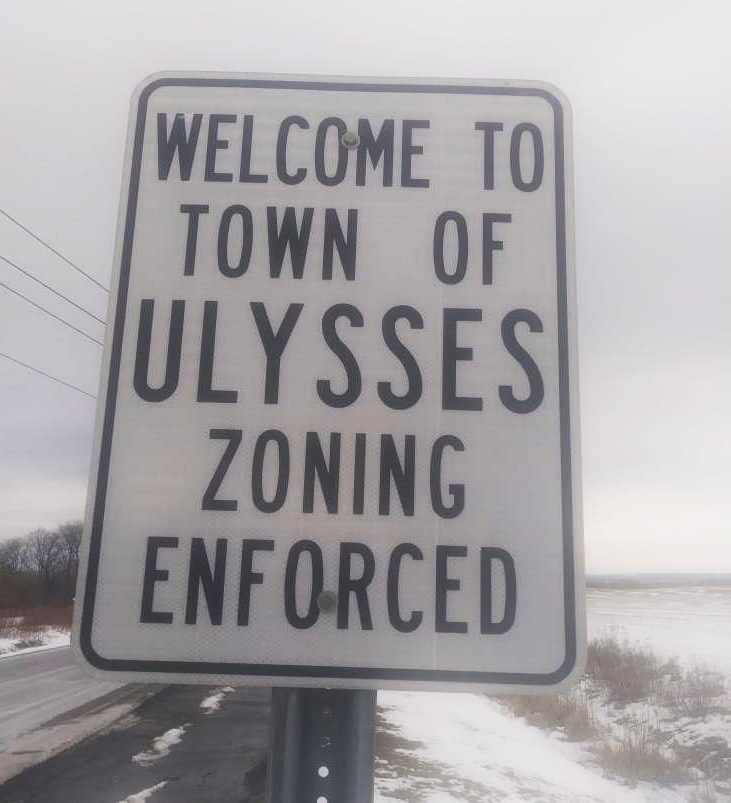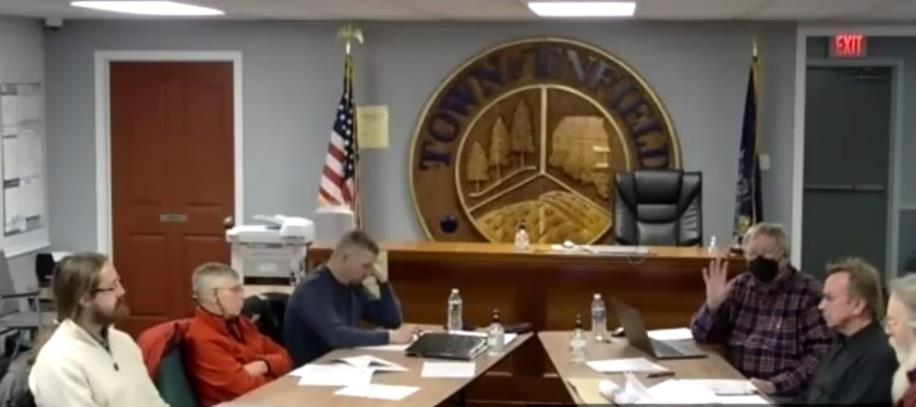Enfield Planners chart contrasting course in Subdivision Rewrite
by Robert Lynch, February 6, 2023
Iradell Road might as well be the 38th Parallel when it comes to land use regulation. Members of the Enfield Planning Board made the point clear last Wednesday night as they devoted more than two hours’ time pondering intricate, often in-the-weeds revisions to Enfield’s decade-old Site Plan Review Law and Subdivision Regulations.

The Planning Board’s months-long effort stands far from finished. The February 1st meeting produced no firm recommendations. But the session did draw a clear dividing line between the mindset of those in un-zoned Enfield to the south and those who govern ultra-zoned Ulysses to the north, Iradell Road their towns’ common border. The Enfield message was clear: What happens in Ulysses should stay in Ulysses.
“I’m also concerned with making it easier for people to build houses in the Town of Enfield,” Planning Board member Mike Carpenter, a builder, told colleagues Wednesday, cautioning them against over-regulation.
“I know that having just tried to build a house in Ulysses for a young family, gone through the Zoning Review Board, gone to the Planning Review Board, and having their new zoning regulations make us have to build a $75,000 bridge over an existing creek in order to fit into the structure of the zoning thing ruined a really good piece of land because the people on the Zoning Board didn’t want to have houses with less than 400-foot frontage in their Town, which is just crazy,” Carpenter said.
Why was it done?
“I believe the Ulysses stated purpose was to preserve the farmland, and they ruined it,” Enfield Planning Board Chair Dan Walker responded. “That’s Ulysses, and we’re not Ulysses,” Walker stressed.
The Town of Ulysses’ revised Zoning Law, enacted amidst controversy in late 2019, has not proved popular, especially with farmers and with those who seek to build homes in Tompkins County’s most northwesterly town. And it has raised the question of when does a law make a minimum-sized building lot simply too big? When does a supposedly well-intentioned rule run counter to a town’s stated desire to preserve rural character? And when do local politicians’ ulterior motives drive their decision-making?
In effect, when does the lot’s size become so huge that it carves up the cornfields and cow pastures that it was supposed to preserve, turning former farmland into super-sized lawns?
The 2019 Ulysses law, according to Enfield planners, demands not only a 400-foot frontage, even on an off-the-road, so-called “flag lot,” but also sets a minimum lot size of five acres, much larger than the average home requires. And as Carpenter sees it, Ulysses couples misguided regulation with arbitrary application.
“When I went to the Board in Ulysses,” Carpenter complained, “and I said I want a variance, the five old white guys on that Board said, ‘This is what the law says. This is what you gotta’ do. We don’t want to give exceptions. It’s a law. We made it. This is what you got to do,’”
So Carpenter’s client had to build the $75,000 bridge.
“That destroys open space,” Walker replied.
“That’s what it does,” Carpenter confirmed.
Why the no-exceptions Ulysses intransigence? Carpenter inferred Ulysses’ leaders had little interest in protecting rural character. “I heard ‘We are protecting our property values;’ that’s what they were saying,” Carpenter told his Board.
“Rural Gentrification,” Walker quickly branded it.
But Ulysses need not get all the blame. Carpenter argued that other rural Tompkins County towns, Caroline and Danby in particular, are doing much the same thing.
So how should Enfield do things differently? How should hometown planners protect rural character—a stated priority in Enfield’s Comprehensive Plan—while not cutting off Enfield’s nose to spite its face? Carpenter, a former Town Board member, led Wednesday’s debate. And Carpenter looked not only to the future, but also to common sense.

“People are building in Enfield, for one reason, because it’s cheaper in taxes; and for another reason, because of the guy sitting over there,” Carpenter said. He pointed to Enfield Code Enforcement Officer Alan Teeter, sitting in the audience.
“Because he is a sensible building inspector,” Carpenter said of Teeter. “He interprets the laws carefully so that his people do safe things and good things, but so that they don’t get pushed out being able to build in the Town by regulation that is so inappropriate that you can’t do it.”
Though not discussed at Wednesday’s session, Tompkins County this year embarked on a consultant’s study into possibly County Government assuming and consolidating code enforcement duties; taking them away from individual towns.
In commissioning the study, County planners and politicians had said they’d envision municipalities’ opting-into unified code enforcement only if they wanted to. Those who’d prefer to enforce their own codes could continue to do so. Nonetheless, the rules could always change. And the prospect of mandatory countywide enforcement worries some in Enfield (not the least of whom is this Councilperson-writer.) We need only look at how Tompkins County’s unique, half-century old, county-wide property assessment bureaucracy has grown increasingly detached from local control.
As those who are expert in the code enforcement field observe, New York imposes a common, state-wide building code. Localities can add to Albany’s rules only minimally. The key lies in enforcement. Does the building inspector enforce those mandates with a velvet glove or an iron fist? Most in Enfield like how Alan Teeter does it.
“Enfield is one of the last holdouts,” Carpenter said, contrasting his town with those neighbors that seek tighter regulation. “And we’re not doing a zoning law.”
During a Planning Board meeting in June of last year, Enfield Supervisor Stephanie Redmond made an offhand remark that town-wide zoning “is something we should consider.” But Redmond later backtracked, apparently sensing zoning’s local unpopularity. Planning Board members also last year expressed reluctance to zone. And while Redmond and some Councilpersons have since called for modestly-increased land regulation, they’ve avoided mentioning the “Z-word,” perhaps respecting the term’s toxicity.
During Wednesday’s Planning Board discussions, Supervisor Redmond offered few comments as she ran the meeting’s streaming controls. No other member of the Town Board participated. State law discourages their input.
“There’s more young people having babies, and the world is just getting way, way bigger,” Carpenter told the Planning Board. “And for me, being one of these reformer people, I’d say let’s put Enfield 50 years ahead of what the world is going to look like, and let’s start making our regulations in keeping with what the world’s going to be looking like 50 years from now, or 20 years from now, or whatever we can deal with.”
Carpenter did not offer specific suggestions Wednesday on how to fulfill his futuristic goal. But he did warn of what to avoid.
“Let’s not look at what happened in the past. Let’s not go to other people’s laws,” Carpenter said. “Let’s think ahead and say, how can we make Enfield a good place to live for everybody; for the new people coming in, for people that have lived here for a long, long time; and not make it the Republican method or the Democrat method, or the ‘I’ve-already-lived-here’ method, or the ‘I-need-someplace-to-live’ method.”
“I’d like at least to think about what do we want Enfield to look like in terms of residential properties in the future,” Carpenter added. “Enfield is a great Bedroom Town right now.”
Board member Henry Hansteen asked what that term meant. Carpenter replied that “Bedroom Town,” to him, meant “a whole bunch of residences, not much business, and there’s no shopping malls here.”
If that’s the definition; yep, that’s Enfield. Carpenter estimated three-quarters of his town’s morning commuters head east, toward Ithaca and Cornell.
Vision eventually stepped aside to make way for substance at the Planning Board meeting. Most carefully examined—in part, an outgrowth from the Ulysses discussion—was how a revised Site Plan Law should treat “flag lots,” those with minimal road frontage but with greater width away from the road and behind other parcels. Board Chair Dan Walker would tighten Enfield’s rules and require any new lot to have as much as 150 feet of road frontage to qualify for review as a “minor” subdivision. Any lot with less road frontage would demand more exacting review as a “major” subdivision. Right now, a subdivided flag lot with as little as 15 feet along the road—a state requirement—can be treated as “minor.”
“I don’t understand the road frontage, 150 feet… why that’s needed?” Hansteen asked.
“I’m not saying you can’t build lots that have 50 feet of frontage or 20 feet of frontage,” Walker said. “But you’re going to go through the major subdivision review process.”
Walker based his proposed revision, in part, on a preference that a flag lot, perhaps one from which many other homes would later branch, should be wide enough to accommodate a future road, and also allow planners’ review to consider future growth.
But Carpenter worried that such heightened subdivision review could burden the builder. “They have to do a whole lot of stuff and spend a whole bunch of money,” Carpenter warned. “And I don’t see that we need to do that.”
Homes set back from roadways are common in Enfield, and they’ve become more common with each passing year. Supervisor Redmond pointed out that she, herself, lives at the back of a quarter-mile driveway.
“It’s happening all over,” Dan Walker responded, noting vacant land’s increasing scarcity.
“People are trying to find a place to build a house,” Carpenter chimed in. He, too, lives far back from the road.
****
The meeting ended with Walker’s road frontage issue unresolved, though the Planning Board did appear headed toward widening a new lot’s required road frontage to at least 20 feet, so as to marry the requirement with that imposed by the state’s Fire Code.
“I think it needs at least 25 feet,” Carpenter interjected. Indeed, the width could widen to 50 feet before the Board’s work is done.
The Enfield Planning Board has set no deadline for completing its Subdivision and Site Plan Law overhaul. Any changes require formal approval by the Town Board.
For the Planning Board, patience and precision appear to outweigh expediency in revising the law so as to suit Enfield best.
“I am just concerned that if we’re going to do this in Enfield, let’s get it right,” Mike Carpenter said.
And of course, the unspoken edict, don’t mimic Ulysses.
###

